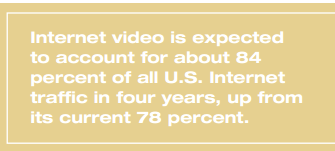By Craig Broadbent, Director of Web Solutions and Client Engagement
How many videos have you watched on YouTube in the past week? A couple of years ago GfK’s syndicated MultiMedia Mentor™ service found that the average person (i.e, those aged between 18 and 64 years old) spent around 23 minutes per day watching Internet video.
Web video has exploded in recent years and its growth is expected to compound over the next few years. According to projections from the Cisco Visual Networking Index 2014, “Internet video is expected to account for about 84 percent of all U.S. Internet traffic in four years, up from its current 78 percent.” Furthermore, mobile video is anticipated to account for nearly three-fourths of the world’s mobile data traffic by 2019.

Figure 1: Mobile Video Will Generate More Than 69 Percent of Mobile Data Traffic by 2019

Does your digital marketing strategy for 2015 include video? Or, are you wondering why your videos aren’t getting the traffic you had hoped or planned for? How do you make video work for your organization successfully?
The first step is to clearly define how your video supports your strategy. Don’t fall into the trap of producing video just for the sake of having video. Purpose and objectives should drive what you do. Starting from that base, there are ways to have success with web video and still do it without a large investment.
At AH, our own in-house digital media team produced a custom, get-to-know-us video in two days for a prospective client. The production of this video sent a strong message that made AH stand out from the competition. Needless to say, the prospective client was so impressed that they decided to partner with AH.
At this past winter’s American Society of Association Executives (ASAE) Technology Conference, I attended a session that highlighted a success story for video. I found it interesting because the video had a relatively large number of views and it was relatively inexpensive to produce.
The video was from the American Chemical Society, the world’s largest scientific society that has 161,000 chemist and chemical engineer members. The society has its own YouTube channel and a small in-house team of two, dedicated to developing Internet video is expected to account for about 84 percent of all U.S. Internet traffic in four years, up from its current 78 percent. 2 video resources and content. In 2014, the society issued over 170 press releases during the year. Of these, the video team selected just under 60 and produced video press releases to complement the written version. These videos are informative, educationally oriented and usually last only about two to three minutes.
For the successful video, the team developed a script and identified/ hired a local videographer to interview and shoot video of the researcher and the facility for a day. They provided the questions to the videographer that would be asked during the interview. The footage did not show an interviewer, but only the response of the person being interviewed. Additionally, the team purchased stock images and video footage for portions that weren’t specific to the research or findings to fill in parts of the prepared script. Other than the interview, the remaining audio was a voice over done by the team. The team also came up with an engaging title to encourage click-through.
The factors that made this video a success were:
- Low cost: Other than the team’s time, the overall cost to produce the video was $1,000. This included the cost to hire the videographer and for the stock images and video.
- High traffic: The video received over 100,000 views in about four months. While this number doesn’t compare to the millions of views received by viral entertainment-oriented videos, relative to the organization’s other videos and the industry this was a great response.
- Return on investment: These results put the cost at less than a penny per view.
- Engaging title: The title is key to breaking through the clutter. Additionally, the content was interesting because it took a very specific and technical topic and linked it with topics that have greater mass appeal.
- Short duration: This video was 1 minute and 48 seconds long. This made for a low-engagement risk for the viewer.
Video doesn’t necessarily need to be expensive or get millions of views in order to be considered successful. You should define success on terms that make sense for you and your organization. Using video as part of your marketing provides a visual piece that can deliver your message with creativity and interactivity.




